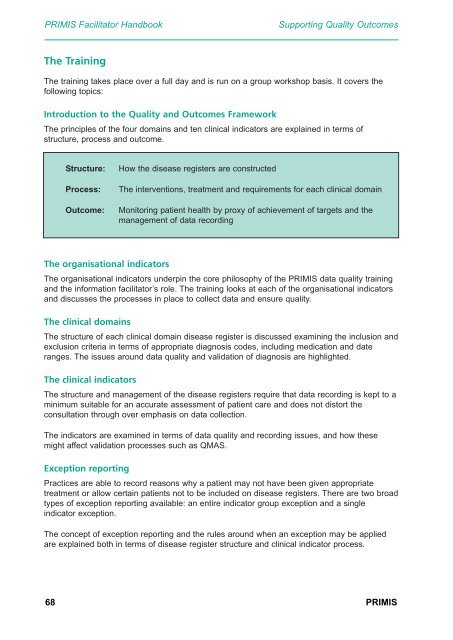Facilitator Handbook 2005 - PRIMIS
Facilitator Handbook 2005 - PRIMIS
Facilitator Handbook 2005 - PRIMIS
You also want an ePaper? Increase the reach of your titles
YUMPU automatically turns print PDFs into web optimized ePapers that Google loves.
<strong>PRIMIS</strong> <strong>Facilitator</strong> <strong>Handbook</strong><br />
Supporting Quality Outcomes<br />
The Training<br />
The training takes place over a full day and is run on a group workshop basis. It covers the<br />
following topics:<br />
Introduction to the Quality and Outcomes Framework<br />
The principles of the four domains and ten clinical indicators are explained in terms of<br />
structure, process and outcome.<br />
Structure:<br />
Process:<br />
Outcome:<br />
How the disease registers are constructed<br />
The interventions, treatment and requirements for each clinical domain<br />
Monitoring patient health by proxy of achievement of targets and the<br />
management of data recording<br />
The organisational indicators<br />
The organisational indicators underpin the core philosophy of the <strong>PRIMIS</strong> data quality training<br />
and the information facilitator’s role. The training looks at each of the organisational indicators<br />
and discusses the processes in place to collect data and ensure quality.<br />
The clinical domains<br />
The structure of each clinical domain disease register is discussed examining the inclusion and<br />
exclusion criteria in terms of appropriate diagnosis codes, including medication and date<br />
ranges. The issues around data quality and validation of diagnosis are highlighted.<br />
The clinical indicators<br />
The structure and management of the disease registers require that data recording is kept to a<br />
minimum suitable for an accurate assessment of patient care and does not distort the<br />
consultation through over emphasis on data collection.<br />
The indicators are examined in terms of data quality and recording issues, and how these<br />
might affect validation processes such as QMAS.<br />
Exception reporting<br />
Practices are able to record reasons why a patient may not have been given appropriate<br />
treatment or allow certain patients not to be included on disease registers. There are two broad<br />
types of exception reporting available: an entire indicator group exception and a single<br />
indicator exception.<br />
The concept of exception reporting and the rules around when an exception may be applied<br />
are explained both in terms of disease register structure and clinical indicator process.<br />
68 <strong>PRIMIS</strong>





